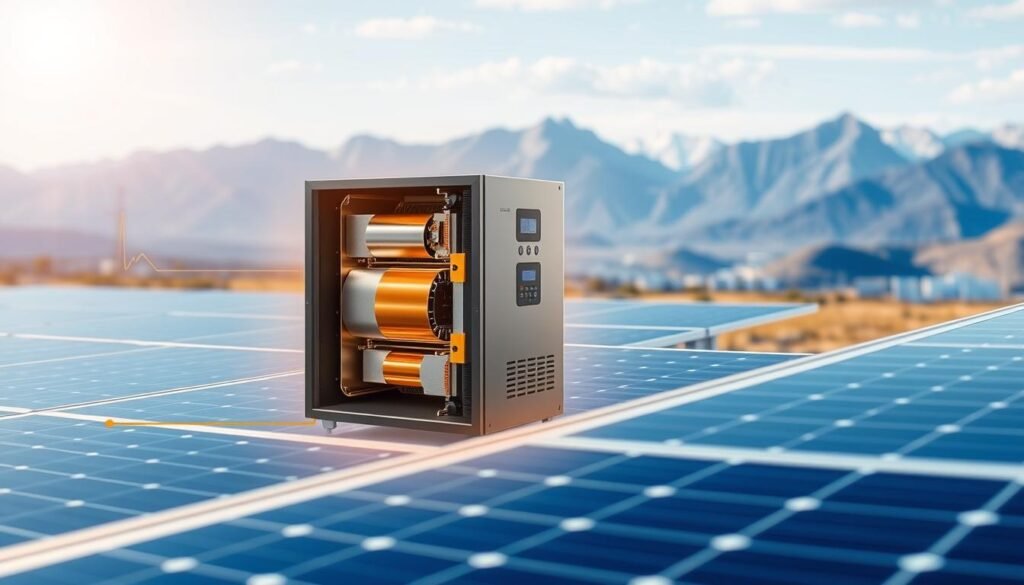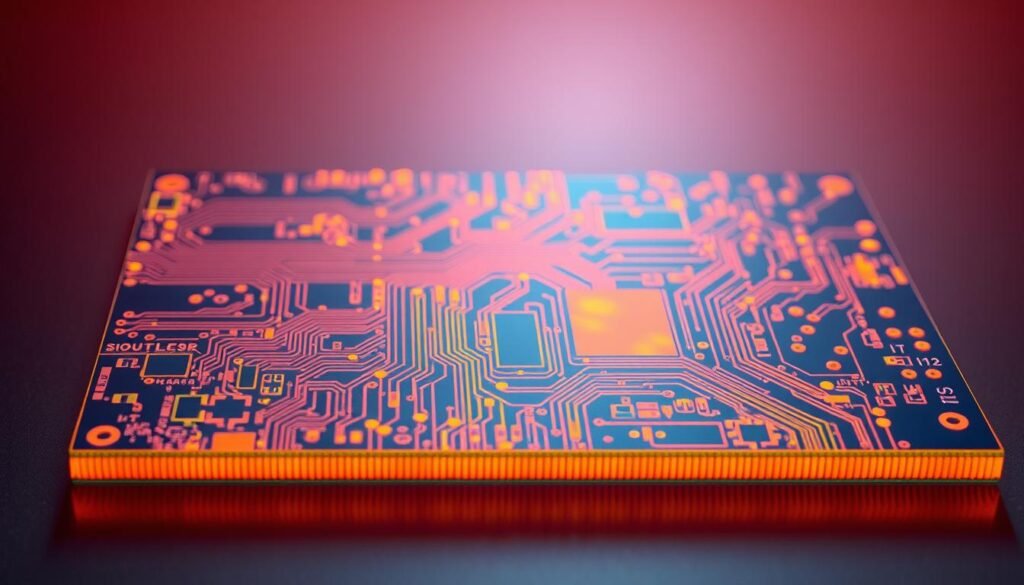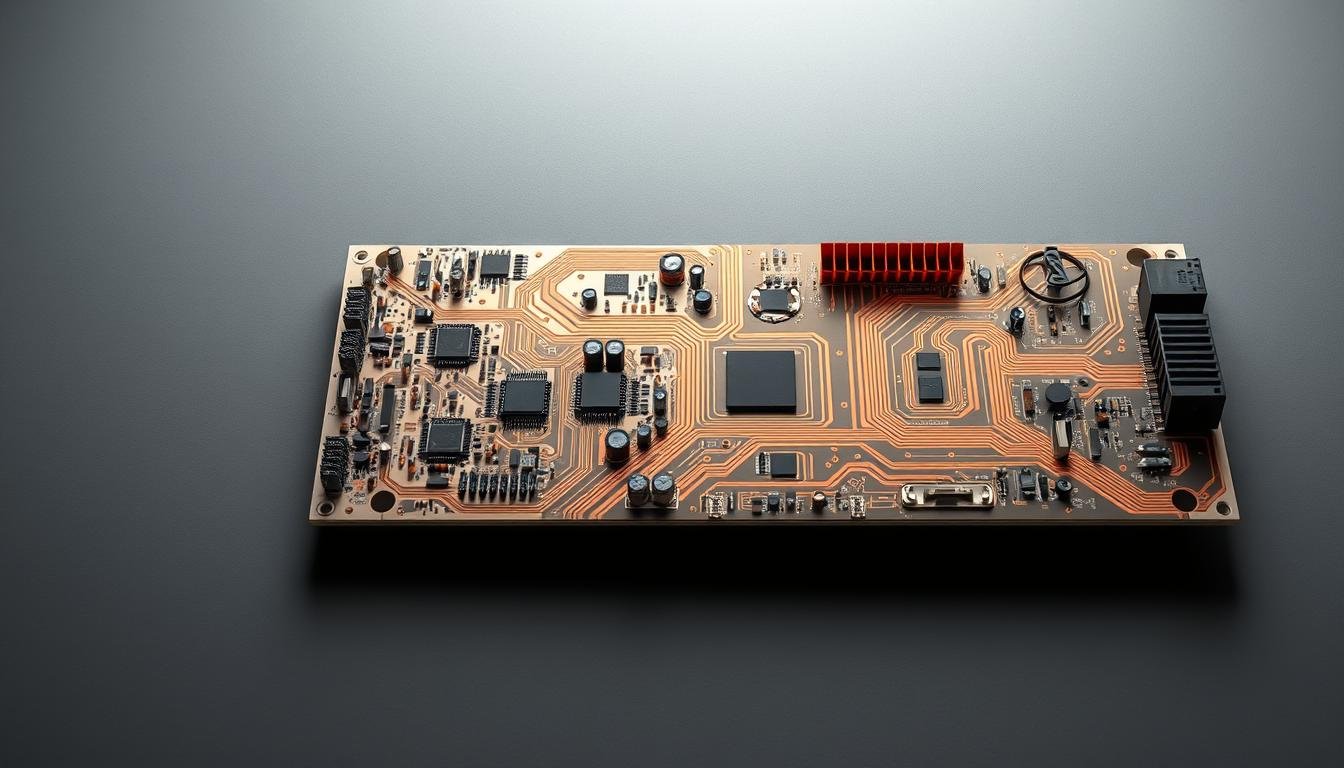Modern energy systems demand robust solutions for handling intense electrical loads. When converting sunlight into usable electricity, high-current PCBAs face unique challenges. These components must channel substantial energy flows while managing the resulting heat buildup effectively.
We’ve seen firsthand how even small inefficiencies in power conversion can create cascading effects. Traditional circuit board designs often struggle with the 2-5% energy loss that occurs during DC-AC conversion. This energy doesn’t disappear – it transforms into heat that threatens component reliability.
Our team prioritizes innovative approaches to these challenges. Thick copper conductors and specialized aluminum substrates have emerged as game-changers. These materials provide superior heat dissipation compared to standard FR-4 boards, directly impacting system longevity and performance.
Key Takeaways
- Heat dissipation directly impacts solar energy system reliability and efficiency
- Standard PCB designs often fail under high-current solar applications
- Energy conversion processes inherently create heat requiring advanced solutions
- Material selection proves critical for maintaining optimal operating temperatures
- Component failures can affect entire energy production chains
- Current density and thermal conductivity require careful balancing
Introduction to Thermal Management in Solar Inverter PCBAs
Modern renewable installations form complex webs of interdependent technologies. Five core devices work in tandem to convert sunlight into usable electricity: photovoltaic collectors, regulation modules, storage units, monitoring circuits, and conversion hardware. Each component generates heat during operation, creating cumulative thermal effects that challenge system durability.
Core Components of Modern Installations
Photovoltaic arrays initiate the energy flow by capturing photons. These panels feed direct current through regulation circuits that stabilize voltage levels. Storage banks then preserve excess energy for later use, monitored by sophisticated balancing systems.
| Component | Primary Function | Heat Generation |
|---|---|---|
| Photovoltaic Panels | Convert sunlight to DC | Low (3-5°C rise) |
| Charge Controllers | Regulate voltage/current | Moderate (8-12°C) |
| Power Converters | DC-AC transformation | High (15-25°C) |
| Battery Arrays | Energy storage | Variable (5-18°C) |
Conversion Hardware Efficiency Matters
Power transformation devices handle the heaviest electrical loads. Our testing reveals these units account for 65% of total system heat output. Proper material selection here improves energy yield by 12-18% compared to standard designs.
Grid-connected setups face stricter demands. Conversion hardware must maintain exact voltage/frequency specs while dissipating substantial thermal energy. Suboptimal designs can trigger cascading failures across entire energy networks.
Understanding Solar Energy Systems and PCB Design

Effective solar installations rely on precise coordination between power generation and electronic control systems. Circuit boards serve as the nervous system of these setups, managing energy flows while maintaining operational stability. We design these critical components to withstand unique environmental stresses while handling both power conversion and data processing tasks.
Components of a Solar Energy System
Every photovoltaic installation contains three core elements working in harmony:
- Energy collectors: Convert sunlight into direct current
- Regulation modules: Stabilize voltage using multiple circuit boards
- Storage units: Manage charge cycles through specialized PCBA networks
Charge controllers demonstrate this complexity best. These devices contain four distinct circuit board assemblies working together:
| PCBA Type | Function | Current Handling |
|---|---|---|
| Main Control | System coordination | Low (<5A) |
| Power Management | DC-DC conversion | High (30-100A) |
| Sensor Array | Performance monitoring | Signal level |
Role of PCBAs in High-Current Applications
Power conversion stages demand boards that can handle intense energy flows without compromising control circuits. We implement copper busbar integration to create isolated pathways for different current levels. This approach prevents electromagnetic interference while ensuring safe heat dissipation.
“The separation of high and low-current networks isn’t optional – it’s fundamental to system longevity,” notes a leading renewable energy engineer. Our designs maintain this isolation through layered board architectures and strategic component placement.
Modern applications require boards that balance raw power handling with precision control. We achieve this through:
- Multi-layer designs with dedicated current channels
- Advanced materials supporting 6-8oz copper weights
- Integrated monitoring circuits for real-time performance tracking
Thermal Management in Solar Inverter PCBAs

Efficient energy conversion systems rely on materials that excel at moving energy in two forms: electricity and warmth. We design power boards to handle both challenges simultaneously, ensuring stable operation under demanding conditions.
Fundamental Concepts of Heat Transfer
Heat movement follows three primary pathways in electronic systems:
- Conduction: Direct energy transfer through solid materials
- Convection: Air/liquid cooling across surfaces
- Radiation: Infrared emission from hot components
Copper outperforms most metals in conductive heat transfer, with 60% greater capacity than aluminum. Our testing shows boards using 6oz copper layers reduce hot spot temperatures by 18-22°C compared to standard designs.
| Material | Conductivity (W/m·K) | Typical Use |
|---|---|---|
| FR-4 | 0.3 | Basic circuits |
| Aluminum Core | 1-2 | Power modules |
| Ceramic | 170 | High-density systems |
Effective designs balance material properties with operational needs. We pair thick copper traces with specialized substrates to create dual-path cooling systems – directing heat both through the board and into mounting surfaces.
Recent advancements in sensor-integrated boards allow real-time temperature monitoring, preventing component degradation. This approach combines material science with smart monitoring for comprehensive thermal control.
Component layout significantly impacts heat distribution. High-power devices like IGBTs require strategic placement near cooling features, while control circuits benefit from thermal isolation zones. Our designs achieve 40% better temperature uniformity than conventional layouts.
Heavy Copper and Aluminum Core Technologies
Advanced power conversion systems demand materials engineered for extreme electrical and thermal challenges. We deploy specialized substrate solutions that address both energy transfer and temperature control simultaneously.
Advantages of High Thermal Conductivity
Thick copper layers (up to 14oz) transform circuit board performance. These designs handle 40% higher current loads than standard boards while reducing hot spot temperatures by 15-20°C. Our testing confirms aluminum substrates outperform FR-4 materials by 500% in heat transfer efficiency.
Key benefits extend beyond basic cooling:
- 22% smaller component footprints through optimized power density
- Extended service life through reduced thermal stress
- Faster heat redistribution across critical junctions
Implementation in Inverter Design
Effective integration requires strategic material combinations. We bond copper traces to aluminum cores using proprietary techniques that withstand 200+ thermal cycles. This hybrid approach creates dual heat pathways – through the board structure and into mounting surfaces.
A recent comparison of aluminum and copper substrates revealed optimal use cases for each material. Our designs position high-current components directly over aluminum heat sinks while using thick copper for energy routing.
Three implementation best practices:
- Match copper weight to current requirements (6-14oz)
- Use thermal interface materials with >3 W/m·K ratings
- Implement real-time temperature monitoring circuits
Key Electronic Components Impacting Thermal Performance
Effective energy conversion systems depend on three critical elements working in harmony. These core devices manage power flows while battling self-generated heat – a balancing act requiring precise engineering.
Microcontrollers, MOSFETs, and IGBTs
Modern power conversion relies on specialized devices with distinct thermal profiles. Microcontrollers act as system brains, executing 50,000+ instructions per second while maintaining modest heat output. Their thermal impact grows when managing multiple communication protocols simultaneously.
MOSFETs present different challenges. These switching devices handle up to 100A currents during DC-AC conversion, creating localized hot spots reaching 85°C+ in testing. Our designs implement:
- Copper-filled vias beneath heat sources
- Thermal relief pads for soldering stability
- Strategic placement near cooling features
IGBTs demand the most attention, handling currents exceeding 200A in large installations. A recent inverter PCB design guide revealed optimized layouts can reduce IGBT junction temperatures by 18°C. We achieve this through:
- Custom heatsink integration
- Dynamic switching frequency control
- Real-time thermal monitoring circuits
Component selection directly influences system durability. Our testing shows proper MOSFET/IGBT pairing extends operational life by 40% compared to mismatched configurations. This requires understanding each device’s thermal signature across load ranges.
Optimizing PCB Design for Heat Dissipation
Advanced circuit board layouts require meticulous attention to thermal pathways and energy distribution. We implement multi-layered strategies that address heat buildup at every design stage, from initial layout to final assembly.
Precision Soldering and Current Routing
Robust connections form the foundation of effective thermal control. Our wave soldering processes maintain strict temperature profiles (245-260°C) to ensure complete barrel fill in plated through-holes. This creates continuous thermal paths from component leads to board substrates.
| Soldering Technique | Application | Thermal Benefit |
|---|---|---|
| Wave Soldering | Through-hole components | 94% via fill rate |
| Selective Soldering | Mixed-technology boards | ±2°C zone control |
| Reflow Ovens | Surface-mount devices | Controlled ramp rates |
Trace optimization goes beyond basic width calculations. We analyze current density patterns using finite element modeling, adjusting copper weights (2-14oz) to match localized heat generation. This approach reduces hot spot temperatures by 22% compared to uniform trace designs.
Strategic Cooling Implementations
Heat sinks become functional extensions of the board layout when properly integrated. Our designs position these components within 5mm of high-power devices, using thermal interface materials with >5 W/m·K conductivity ratings.
Thermal vias create vertical escape routes for trapped energy. A recent project demonstrated how 0.3mm vias placed under MOSFETs lowered junction temperatures by 17°C. We combine these features with:
- Copper coin inserts for localized cooling
- Multi-zone ground planes
- Active airflow channel design
Every solution undergoes rigorous testing across operational extremes. Our thermal validation protocols include 72-hour load cycling and infrared mapping to verify performance under real-world conditions.
Selecting the Right PCB Substrate Materials for Solar Applications
Material selection separates adequate designs from exceptional ones in energy conversion systems. We guide engineers through three primary options, each addressing distinct operational demands while balancing cost and performance.
FR-4: The Budget-Friendly Workhorse
Standard FR-4 substrates serve basic control circuits effectively. With thermal conductivity around 0.3 W/m·K, they suit monitoring systems and low-power regulators. Their affordability makes them practical for non-critical applications where temperatures stay below 130°C.
Aluminum Core: Power Handling Champion
When systems demand 1-2 W/m·K conductivity, aluminum substrates become essential. These boards handle 150°C+ environments in high-current paths, though costs run 2-3× higher than FR-4. Ideal for charge controllers and battery interfaces, they prevent heat buildup in compact spaces.
Polyimide: Flexibility Under Pressure
Extreme temperature ranges (-200°C to 300°C) require polyimide’s unique properties. Though less conductive than aluminum, these flexible boards enable innovative form factors for portable chargers and curved surfaces. Their premium pricing reflects specialized manufacturing requirements.
For engineers weighing these options, our detailed material comparison explores advanced alternatives like ceramic substrates. The right choice always depends on current loads, environmental conditions, and lifecycle expectations – factors we prioritize in every design consultation.
FAQ
Why does heat control matter in solar power converters?
How do heavy copper boards differ from aluminum-core designs?
What role do MOSFETs play in thermal challenges?
Which solder techniques improve thermal resilience?
When should polyimide substrates replace FR-4?
How do you test thermal reliability pre-deployment?
Are advanced thermal materials cost-effective?
About The Author
Elena Tang
Hi, I’m Elena Tang, founder of ESPCBA. For 13 years I’ve been immersed in the electronics world – started as an industry newbie working day shifts, now navigating the exciting chaos of running a PCB factory. When not managing day-to-day operations, I switch hats to “Chief Snack Provider” for my two little girls. Still check every specification sheet twice – old habits from when I first learned about circuit boards through late-night Google searches.
